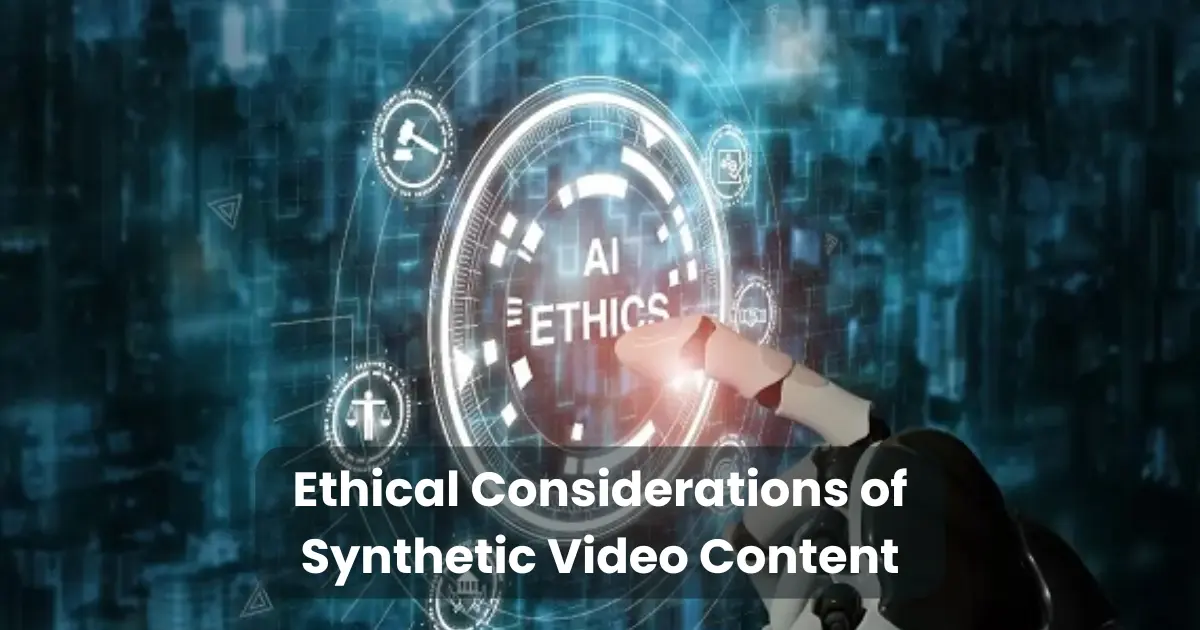Ethical Considerations of Synthetic Video Content

Contents
The ethical considerations of synthetic video content have become a pressing concern in today’s digital landscape. As deep learning and artificial intelligence technologies advance, they increasingly generate hyper-realistic videos, raising questions about their moral and societal implications. Creators can produce these videos in a matter of minutes, and they are often indistinguishable from real footage. They have already found applications in marketing, entertainment, education, and even journalism.
However, alongside their potential for innovation, serious concerns have been expressed. Privacy can be violated, misinformation can be spread, and trust in media can be eroded. Consequently, many sectors ranging from government institutions to tech companies have begun to scrutinize the responsible use of this content. Ethical challenges have not only emerged but are now actively influencing discussions on regulation and technological boundaries.
Therefore, it is vital to explore the ethical landscape surrounding synthetic media. In doing so, we can better understand both the benefits and dangers, while identifying clear strategies for responsible use and accountability.
Understanding Synthetic Video Content
Artificial intelligence, particularly deep learning algorithms, digitally creates or manipulates synthetic video content. Unlike traditional video editing, where visual changes are manually applied, AI systems autonomously generate this content after being trained on vast datasets. This includes deepfakes, motion capture replacements, virtual avatars, and even completely fabricated scenes.
At its core, this technology operates by analyzing real video footage and learning how to recreate realistic patterns of speech, facial expressions, and body movements. Once trained, the AI can generate new video material that mimics a subject with startling accuracy. As a result, synthetic video has been embraced in various industries from automating dubbing in different languages to generating realistic simulations for training and education.
Despite its technical marvels, we cannot ignore the ethical considerations of synthetic video content. When creators can fabricate content to such a degree of realism, it becomes difficult to discern fact from fiction. Moreover, when individuals’ likenesses are used without their consent, they can suffer personal and societal harm.
The Rise of Deepfakes and AI-Generated Media
Over the past few years, the creation and distribution of deepfakes and other forms of AI-generated media have increased at an unprecedented rate. Deepfakes, in particular, have become a symbol of the ethical considerations of synthetic video content. Deep neural networks, especially Generative Adversarial Networks (GANs), enable creators to swap faces, replicate voices, and digitally recreate entire personas—often without informing or obtaining consent from the individuals involved.

Initially, deepfakes emerged as a form of internet novelty. People initially used them for humor, satire, and harmless entertainment. However, as the technology improved, others rapidly adopted it for more controversial purposes. Creators have shown political figures saying things they never said and placed celebrities in fabricated scenarios. Everyday individuals have become targets of synthetic revenge content, which has raised severe concerns around privacy and digital consent.
In addition, AI-generated media has been used to automate news anchors, simulate historical figures, and even generate influencers who do not actually exist. While some of these uses are creative and even educational, others have blurred the lines between reality and fabrication.
Because of its high potential for manipulation, the ethical considerations of synthetic video content have captured global attention. This technology has undermined public trust in visual media, and it has compelled law enforcement, media outlets, and ethical boards to rethink their approaches to content verification and digital accountability.
Ethical Considerations of Synthetic Video Content
The ethical considerations of synthetic video content are multifaceted and touch on several sensitive societal issues. While synthetic media holds potential for creative and commercial benefits, its ability to distort reality, infringe on personal rights, and manipulate public perception cannot be overlooked. Below are the key ethical concerns that must be addressed.
1. Consent and Privacy Violations
One of the most significant ethical challenges is the use of someone’s likeness or voice without consent. Using synthetic video tools, creators can make a person appear in a video they never participated in, saying or doing things they never did. People have used these fabrications to harass individuals, produce fake pornography, and damage reputations.
In many cases, victims are not even aware that their image is being used. Their privacy is invaded, and their identity is exploited all without permission. As a result, the ethical considerations of synthetic video content demand that consent becomes a foundational requirement in content creation.
2. Misinformation and Manipulation
Another major concern revolves around the spread of misinformation. Creators can use synthetic videos to impersonate politicians, business leaders, or public figures, influencing elections, inciting panic, or damaging reputations. Since these videos appear so realistic, viewers often accept them as truth before fact-checkers have a chance to intervene.
Therefore, the ethical considerations of synthetic video content must include a focus on societal harm. The potential to sway public opinion through fake visuals puts democracies and civil discourse at risk.
3. Authenticity and Trust
Trust in visual media has traditionally been high. Seeing used to be believing. However, with synthetic content, that trust is being eroded. Journalistic integrity, courtroom evidence, and educational media all rely on the authenticity of video content.
When manipulated videos enter these domains, viewers are left questioning the credibility of even legitimate sources. Thus, the ethical considerations of synthetic video content include the duty to protect the integrity of truth-based institutions.
Legal Implications and Grey Areas
While the technological advancements behind synthetic media have progressed rapidly, the legal frameworks governing them have lagged behind. This gap has created a variety of grey areas where people often blur ethical boundaries and struggle to enforce accountability. As a result, we must evaluate the ethical considerations of synthetic video content alongside evolving legal standards.
In many jurisdictions, existing laws around defamation, impersonation, and data protection are being applied to synthetic media. However, these laws were not designed with AI-generated content in mind. As a result, victims of synthetic video misuse may struggle to obtain justice, especially when perpetrators are anonymous or based in other countries.
Furthermore, synthetic recreations of celebrities, voice actors, or digital replicas of deceased individuals have challenged intellectual property rights. In these cases, creators may violate likeness rights, turning the ownership of one’s digital identity into a contentious issue. Although some regions have introduced specific deepfake laws, enforcement remains inconsistent.
Adding complexity is the role of intent. Not all synthetic content is created with malicious intent some is satirical, artistic, or educational. But distinguishing between harmful and harmless use is difficult without clear legal definitions. This ambiguity further highlights the ethical considerations of synthetic video content, as it forces society to grapple with questions like: Who owns a digital likeness? What constitutes consent in AI-generated media? Should creators be punished if no harm was intended?
Therefore, there is an urgent need for comprehensive regulation that balances innovation with protection offering legal clarity while upholding individual rights and ethical standards.
Industry and Platform Responsibilities
As synthetic video technologies continue to proliferate, responsibility does not fall solely on creators or lawmakers. A significant share must also be assumed by the industries developing these tools and the platforms distributing the content. The ethical considerations of synthetic video content become especially critical at this level, where scale and influence amplify both benefits and risks.

Technology companies that build AI tools capable of generating synthetic videos have an ethical obligation to embed safeguards. These might include watermarking features, consent verification, and usage restrictions. If tools are released without adequate protections, they can be misused by malicious actors with little to no resistance. In recent years, some firms have responded by requiring identity verification or restricting access to advanced features, but these efforts are not yet universal.
Social media platforms and video hosting services also play a vital role. When deepfakes or synthetic clips go viral, they can cause rapid and widespread harm. Therefore, platforms must implement detection mechanisms, flagging systems, and responsible moderation to reduce the damage caused by deceptive content. They must also actively enforce policies rather than merely outlining them in their terms of service.
In addition, transparent labeling of AI-generated media could help viewers distinguish synthetic content from authentic footage. Despite the complexities, many believe that the ethical considerations of synthetic video content should push platforms to act not only as neutral hosts but also as ethical gatekeepers.
Developers, platforms, and regulators can create a more accountable digital ecosystem by working together one that encourages innovation while minimizing abuse.
Ethical Frameworks and Guidelines
To navigate the growing complexity of AI-generated content, structured ethical frameworks are essential. These frameworks can serve as a moral compass for developers, users, and institutions alike. We must approach the ethical considerations of synthetic video content with clarity, consistency, and foresight to ensure that technology evolves responsibly alongside societal values.
Several international organizations and academic institutions have begun drafting AI ethics principles, many of which are directly applicable to synthetic media. Key principles often include:
- Transparency: Creators should disclose when they have synthetically generated content. Whether through visual markers, metadata, or explicit disclaimers, they must inform audiences about what they are watching.
- Accountability: Responsibility for misuse should be traceable. Developers and platforms must implement policies that track the source of synthetic content and hold violators accountable.
- Informed Consent: Individuals whose images, voices, or likenesses are used in synthetic video must give explicit permission. This is especially crucial in commercial, political, or intimate contexts.
- Harm Prevention: Creators should refrain from publishing a synthetic video if it has the potential to cause emotional, psychological, or reputational harm. Ethical decision-making should always consider the potential impact on affected parties.
- Bias and Fairness: AI models must be audited for biases. Without proper oversight, synthetic content generators may replicate or amplify harmful stereotypes.
Importantly, these ethical guidelines must be made adaptable, as the technology is evolving rapidly. Institutions should continually revise and update their approaches based on emerging risks and societal feedback. The ethical considerations of synthetic video content require not just static rules, but dynamic, responsive frameworks that reflect real-world complexities.
Future Outlook and Innovations
As synthetic video technology continues to evolve, its future holds both tremendous potential and significant risk. From revolutionizing education through personalized tutors to creating inclusive entertainment with multilingual avatars, the possibilities are vast. However, the ethical considerations of synthetic video content will become even more important as these innovations scale globally.

Emerging innovations aim to make synthetic content generation more accessible, intuitive, and realistic. Real-time deepfakes, voice cloning apps, and low-latency virtual influencers are rapidly gaining traction. With generative AI becoming more democratized, even individuals with limited technical skills will be able to create highly realistic video content.
At the same time, efforts to counteract misuse are also accelerating. Researchers and developers are exploring AI-driven detection tools, blockchain-based content verification, and tamper-evident watermarks as solutions to maintain trust in visual media. Additionally, governments and multinational bodies are beginning to propose comprehensive regulations to ensure that the development of synthetic video aligns with public interest.
Looking ahead, collaboration will be key. Technology developers, policymakers, educators, and ethicists must work together to shape a future where innovation thrives—but not at the expense of truth, privacy, or trust. The ethical considerations of synthetic video content should not be seen as barriers to progress but as guiding principles that ensure this powerful technology is used for good.
Conclusion
As synthetic video technologies become increasingly embedded in our digital landscape, their influence will continue to expand across entertainment, education, marketing, politics, and beyond. However, with great creative power comes serious ethical responsibility. The ethical considerations of synthetic video content including consent, authenticity, misinformation, and legal ambiguity—demand thoughtful action from all stakeholders.
While technological advancement cannot and should not be halted, it must be guided by clear principles that protect individual rights and uphold societal trust. Industry leaders, regulators, and content creators must collaborate to establish enforceable guidelines, foster transparency, and ensure that innovations serve the greater good. Transitioning into the future, synthetic video content may redefine how we share stories, visualize ideas, and engage with the world. But it will be through ethical foresight and continuous dialogue that we determine whether this transformation will be constructive or corrosive.






